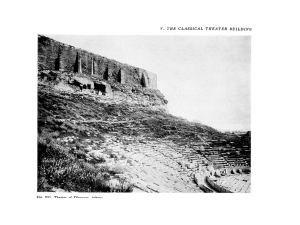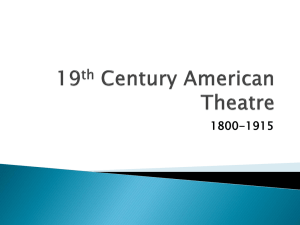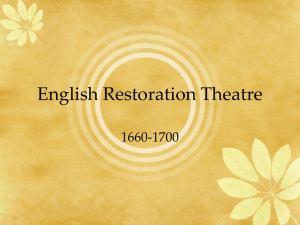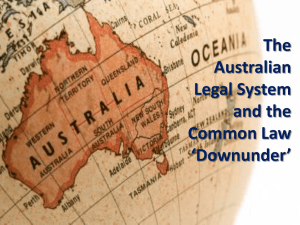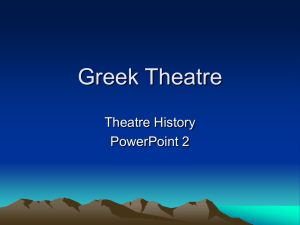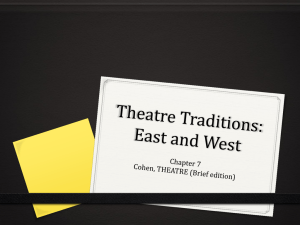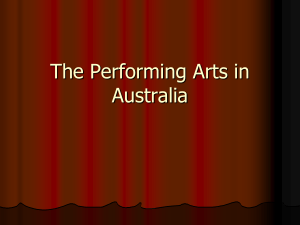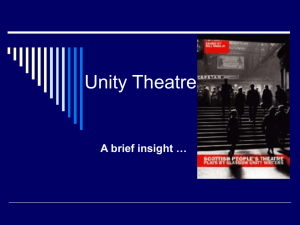File
advertisement
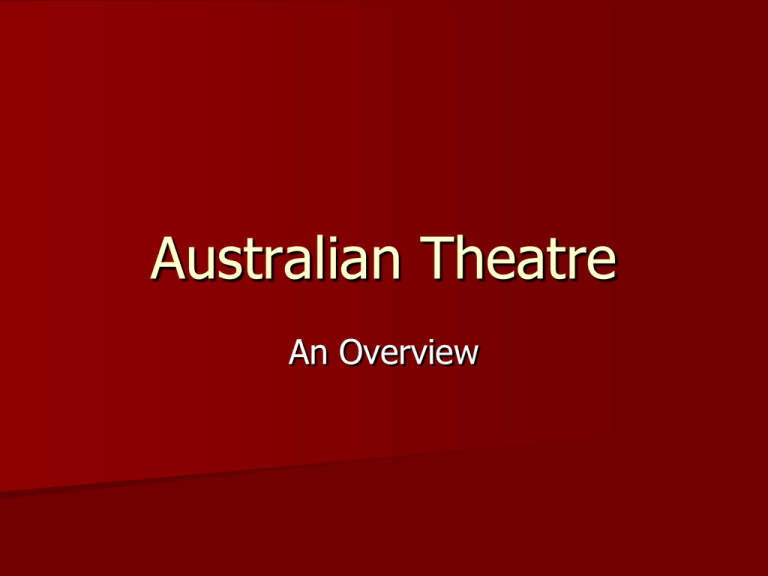
Australian Theatre An Overview Early History Australia’s first settlers sought to reproduce the theatre they had left behind when they arrived here in the late 18th century Because Australia was a convict settlement this produced interesting results, as conditions could not have been more different Port Arthur Convict Settlement, Tasmania It is believed the first play was performed in a small mud hut in 1789 At that time Restoration comedy was popular in England so that was the style of drama copied here Restoration comedy was based on the manners and lifestyles of the aristocracy, or rich people Restoration Comedy Convict Theatre During the 1800’s convicts engaged in acting and staging many plays This was vigorously opposed by many Drama seemed like too much fun and enjoyment and convicts were supposed to being punished not rewarded for their crimes Convict chain gangs The Plays Much of the drama was from England A few Australian plays were now being written - eg, The Bushrangers by David Burn in 1829 Plays like this about the convicts’ conditions, bushrangers, etc, were not allowed to be performed because they described the terrible conditions of life for the convicts. Edward Geoghegan wrote his play “The Currency Lass” in 1844 Legislation was passed by the government declaring that plays had to meet certain conditions before they could be performed Opening of Theatres In 1833 the Sydney Theatre Royal opened It imitated an English theatre It had a proscenium arch stage It set the standard for other Australian states to follow Sydney Theatre Royal Audiences enjoyed light entertainment Life in Australia was hard at that time However there were problems because theatre was badly organised 1850’s Gold Rushes Gold was discovered in 1850 A rush of people arrived in Australia to search for gold and make their fortunes More people were going to the theatres New theatres were being built George Coppin, an entrepreneur invited an American performer, J. C. Williamson, to come to Australia to perform. Williamson enjoyed great success A Gold Miner’s Licence George Coppin J. C. Williamson He was married to Maggie Moore They both acted and managed their successful plays The plays were all musicals from overseas They encouraged overseas stars to tour One of these was the famous actress Sarah Bernhardt Overseas performers had to travel to Australia by ship J C Williamson Maggie Moore, his wife The married couple, both actors Sarah Bernhardt Audiences loved the overseas entertainers but this discouraged the writing and staging of home grown Australian plays Vaudeville dominated the stages of the 1890’s Vaudeville was a variety style with music, dancing and comedy skits Vaudeville Examples Acceptance of Australian Content Radio developed in the 1920’s Quiz shows, radio plays (serials and dramas) developed with a uniquely Australian flavour In 1954 the Australian Elizabethan Trust was set up This gave Australian drama the opportunity to come to the foreground in Australian theatres The aims of the trust were to encourage Australian writing and performers Playwright – Ray Lawler “Summer of the Seventeenth Doll” A great success with critics and audiences A realistic play about two North Queensland cane cutters, Barney and Roo, who came down to Melbourne where they meet and develop relationships with nancy and Olive Ray Lawler Summer of the Seventeenth Doll It was both moving and funny It changed Australian theatre forever It gave permission for Australians to support their own culture, rather than Australian work being seen as second rate compared with English and American works Many other Australian plays soon followed The Introduction of TV in Australia 1956 was the dawn of television in Australia It meant that actors, directors and writers had another avenue for their work NIDA Another milestone for Australian theatre was the establishment of NIDA in 1958 NIDA – National Institute for Dramatic Art NIDA has profoundly impacted the training of Australian actors, directors and designers. Mel Gibson and Nicole Kidman were both students at NIDA Other states introduced their own courses in dramatic arts – Victorian College of the Arts in Victoria The Sixties Life was moving rapidly during the 1960’s It was a time of great change and upheaval Much experimentation was happening in drama around the world. People struggled to make sense of it all Alternative theatre required little money and much innovation and experimentation. It thrived. Australian Playwrights John Romeril Jack Hibberd David Williamson Barry Oakley Tim Roberts Barry Dickens Louis Nowra Female playwrights of the late 20th and early 21st centuries Joanna Murray-Smith Hannie Rayson Alma de Groen Indigenous Drama Stolen by Jane Harrison Yanagai! Yanagai! “Stolen” by Jane Harrison Yanagai! Yanagai! Australian Theatre Today After initial experimentation and searching for an identity, Australian theatre has become diverse Playwrights have broadened their views and theie world Louis Nowra, Stephen Sewell, Ron Elisha, Michael Gow have been praised for their plays Many community theatres have been established Community theatre groups are created to meet the needs of particular groups Limited grants are distributed by various government bodies to support the arts Even major theatre companies like Melbourne Theatre Company and The Malthouse rely on government grants and sponsorship from business Although the big American and English blockbuster musicals, like Miss Saigon, still receive the greatest box office support (they sell the most tickets), the richness and diversity of mainstream and alternative Australian theatre continues to survive Miss Saigon Theatre Companies MTC Melbourne Theatre Company The Malthouse La Mama Bell Shakespeare And many others You can check out the websites of these companies or look for their up coming shows in major newspapers.
